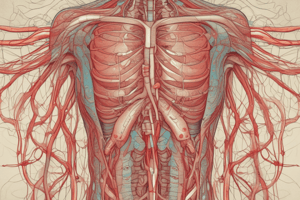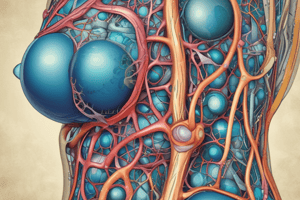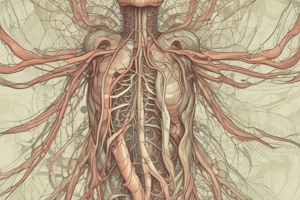Podcast
Questions and Answers
Name the primary lymphoid organs of the lymphatic system.
Name the primary lymphoid organs of the lymphatic system.
Bone Marrow and Thymus
Which organs are part of the secondary lymphoid organs? (Select all that apply)
Which organs are part of the secondary lymphoid organs? (Select all that apply)
- Tonsils (correct)
- Mucosa of the digestive tract (correct)
- Aggregates of lymphocytes in the lung
- Lymph nodes (correct)
- Spleen (correct)
The thymus is most active during adulthood.
The thymus is most active during adulthood.
False (B)
Antigens are recognized by cells of the adaptive immune system through specific molecular domains known as ________.
Antigens are recognized by cells of the adaptive immune system through specific molecular domains known as ________.
Match the following classes of antibodies with their descriptions:
Match the following classes of antibodies with their descriptions:
What is the function of the Blood-Thymus Barrier?
What is the function of the Blood-Thymus Barrier?
The Thymic medulla is responsible for inducing apoptosis in T cells with TCRs that bind strongly to self-proteins.
The Thymic medulla is responsible for inducing apoptosis in T cells with TCRs that bind strongly to self-proteins.
Which of the following are types of MALT (Mucosa-Associated Lymphoid Tissue)?
Which of the following are types of MALT (Mucosa-Associated Lymphoid Tissue)?
The spleen consists of two intermingled regions: white pulp and red pulp. White pulp is associated with _________ arterioles.
The spleen consists of two intermingled regions: white pulp and red pulp. White pulp is associated with _________ arterioles.
Study Notes
Lymphatic System
- The lymphatic system is responsible for fluid balance, fat absorption, and defense.
Components of the Lymphatic System
- Primary lymphoid organs:
- Bone Marrow
- Thymus
- Secondary lymphoid organs:
- Lymph nodes
- Spleen
- Tonsils
- Aggregates of lymphocytes and antigen-presenting cells in the lung (BALT) and the mucosa of the digestive tract (GALT), including Peyer’s patches
Types of Immunity
- Innate or Natural Immunity:
- Provides immediate defense against infection
- Physical barriers: skin, mucous membranes, and tears
- Chemical barriers: HCl, organic acids, defensins, and lysozyme
- Cellular barriers: neutrophils, natural killer cells, and toll-like receptors
- Adaptive Immunity:
- Acquired gradually by exposure to microorganisms
- More specific and slower to respond
- T cell immunity: cellular mediated immunity and cytokine production
- B cell immunity: humoral immunity and antibody production
Innate Immunity
- Physical barriers:
- Skin and mucous membranes
- Tears, saliva, and urine
- Chemical barriers:
- HCl and organic acids
- Defensins and lysozyme
- Cellular barriers:
- Neutrophils and natural killer cells
- Toll-like receptors
Adaptive Immunity
- T cell immunity:
- Cellular mediated immunity
- Cytokine production
- Uptake of a pathogen by phagocytes
- Passive and active immunity
- B cell immunity:
- Humoral immunity
- Antibody production
- Antigen exposure
Antigens and Antibodies
- Antigen:
- A molecule recognized by cells of the adaptive immune system
- Examples: foreign matter, bacteria, and viruses
- Antibodies:
- Proteins produced by plasma cells in response to antigens
- Examples: IgG, IgA, IgM, IgE, and IgD
Classes of Antibodies
- IgG: most common antibody in the blood
- IgA: found in mucosal surfaces
- IgM: first antibody produced in response to an infection
- IgE: involved in allergic reactions
- IgD: found on the surface of mature B cells
Antigen Presentation
- Major Histocompatibility Complex (MHC):
- A group of genes that code for proteins found on the surfaces of cells
- Helps the immune system recognize foreign substances
- Also known as Human Leukocyte Antigen (HLA)
- Two classes of MHC:
- CLASS 1: found on all nucleated cells
- CLASS 2: found on antigen-presenting cells
Cells of Adaptive Immunity
- Antigen-presenting cells:
- Detect, engulf, and inform the adaptive immune response about an infection
- Examples: dendritic cells, macrophages, monocytes, and thymic epithelial cells
- Lymphocytes:
- Regulate and carry out adaptive immunity
- Found in the bone marrow and lymphoid tissues
- Have specific receptors on their surface
Lymphocytes
- T lymphocytes:
- Recognize antigenic epitopes via surface protein complexes termed T-cell receptors (TCRs)
- Types:
- Helper T cells (CD4 T lymphocytes)
- Cytotoxic T cells (CD8 T cells)
- Regulatory T cells (Tregs or suppressor T cells)
- γδ T lymphocytes
- B lymphocytes:
- Recognize specific antigens via surface protein complexes termed B-cell receptors (BCRs)
- Produce antibodies in response to antigens
Lymphoid Tissue
- Reticular connective tissue is filled with large numbers of lymphocytes
- Lymphoid tissue packed with lymphocytes usually stains dark blue in hematoxylin and eosin
- Reticular fibers are found in lymphoid tissue### Thymic Epithelial Cells (TECs)
- TECs are epithelial reticular cells with oval nuclei and lightly stained cytoplasm with processes.
- They play a crucial role in the development of T cells in the thymus.
Blood-Thymus Barrier
- The blood-thymus barrier exists in the cortex of the thymus, making it an immunologically protected region.
- The barrier consists of:
- Endothelium of the thymic capillaries and the associated basal lamina.
- Perivascular connective tissue and cells (e.g., pericytes and macrophages).
- Type I epithelial reticular cells and their basal laminae.
Thymus
- The thymus is a primary lymphoid organ where T cells develop and mature.
- T lymphoblasts, or thymocytes, attach to a cytoreticulum composed of interconnected TECs.
- TECs secrete many cytokines, compartmentalize the thymus into a cortex and a medulla, and surround blood vessels in the blood-thymus barrier.
- Developing T cells with nonfunctional TCRs are detected and removed in the thymic cortex by a process of positive selection.
- Cells with functional TCRs move into the thymic medulla, where they undergo negative selection, leading to central immune tolerance.
Thymic Medulla
- The thymic medulla contains Hassall corpuscles, which are aggregates of TECs that promote the formation of regulatory T cells.
- Regulatory T cells form in the thymic medulla upon interacting with dendritic cells presenting self-antigens.
Secondary Lymphoid Organs
- Secondary lymphoid organs include lymph nodes, spleen, tonsils, Peyer's patches, and mucosa-associated lymphoid tissue (MALT).
Mucosa-Associated Lymphoid Tissue (MALT)
- MALT is found in the mucosa of most tracts, including the palatine, lingual, and pharyngeal tonsils, Peyer's patches, and the appendix.
- MALT is composed of dispersed aggregates of non-encapsulated organized lymphoid tissue within the mucosa.
Types of MALT
- Tonsils: large, irregular masses of lymphoid tissue in the mucosa of the posterior oral cavity and nasopharynx.
- Peyer's patches: clusters of subepithelial, lymphoid follicles found in the intestine.
- Appendix: a short, small-diameter projection from the cecum, filled with lymphoid tissue.
Lymph Nodes
- Lymph nodes filter lymph and provide a site for B-cell activation and differentiation to antibody-secreting plasma cells.
- Each lymph node has three functional but not physically separate compartments: an outer cortex, an underlying paracortex, and an inner medulla.
Lymph Node Cortex
- The cortex is the outer region of the lymph node, where B cells encounter antigens, proliferate, and then move into the deeper regions of the lymph node.
- The cortex contains lymphoid nodules, which are organized around the long, interdigitating processes of follicular dendritic cells (FDCs).
Lymph Node Paracortex
- The paracortex is the region between the cortex and medulla, characterized by the lack of nodules.
- The paracortex contains specialized post-capillary venules called high endothelial venules (HEVs), which are an important entry point for most circulating lymphocytes into lymph nodes.
Lymph Node Medulla
- The medulla is the inner region of the lymph node, adjacent to the hilum and efferent lymphatic.
- The medulla contains medullary cords, which are branched cordlike masses of lymphoid tissue, and medullary sinuses, which are dilated spaces lined by discontinuous endothelium.
Spleen
- The spleen is a large lymphoid organ without a cortex/medulla structure, instead, it has two intermingled but functionally different regions: white pulp and red pulp.
- White pulp is secondary lymphoid tissue associated with small central arterioles, enclosed by periarteriolar lymphoid sheaths (PALS) of T cells.
- Red pulp filters blood, removes defective erythrocytes, and recycles hemoglobin iron, and consists of splenic cords with macrophages and blood cells of all kinds, and splenic sinusoids.
Studying That Suits You
Use AI to generate personalized quizzes and flashcards to suit your learning preferences.
Description
This quiz covers the overview, functions, and components of the lymphatic system, including histology, immunology, and organs such as the thymus, spleen, and lymph nodes.




